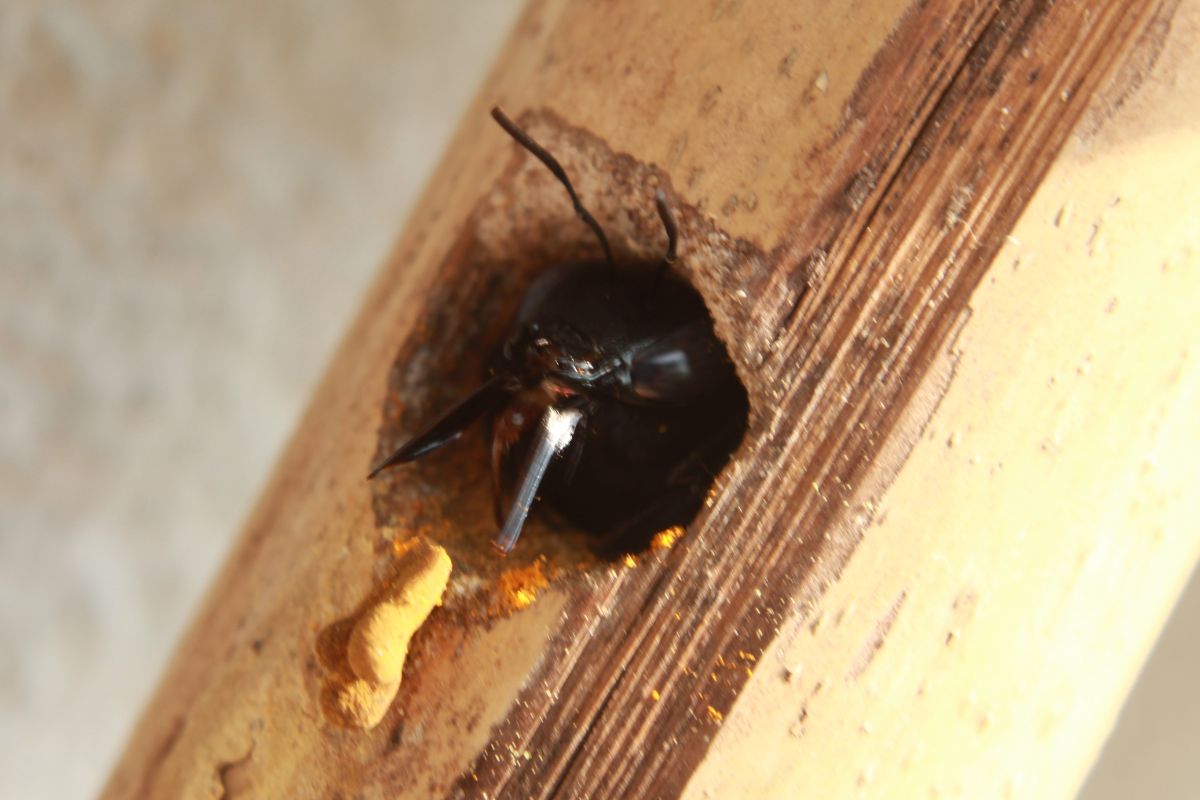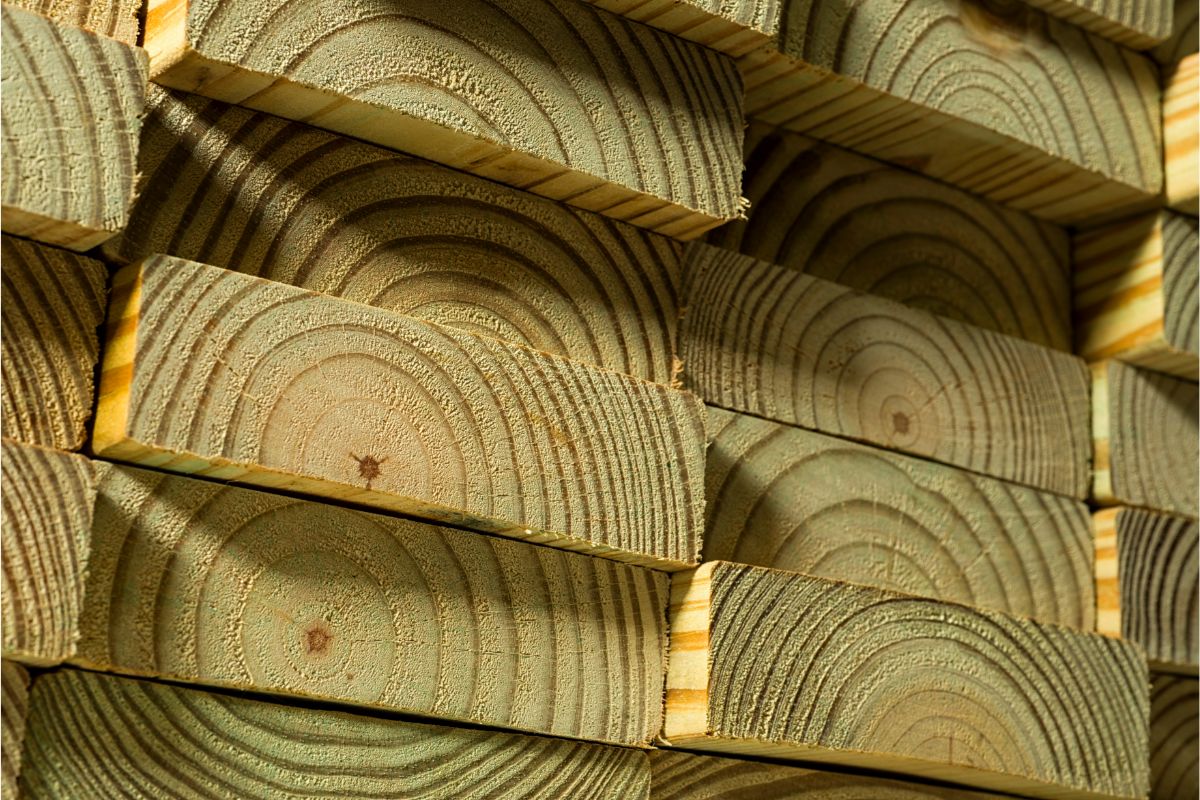Contents
Although they are beneficial to the environment as excellent pollinators, carpenter bees can cause a lot of damage to the wood in and around your home.

So with this guide we will help you spot the signs of this bee infestation and tell you how to protect wood from carpenter bees.
What Are Carpenter Bees?
Carpenter bees have a similar body shape to a bumble bee, but their abdomens are shiny, black and hairless. They have different nesting habits too, tunneling into wood to lay their eggs, and they do not live in colonies like other bees.
In the spring the female creates a tunnel with chambers to deposit her eggs and then seals them up to allow the larvae to develop. The male will winter alone in previously bored brood tunnels.
What Are The Signs Of A Carpenter Bee Infestation?
If you are wondering how you would know if you have a carpenter bee infestation there are a few signs to look out for.
Odd Holes In The Wood
The holes made by carpenter bees are perfectly round and if you didn’t know better you would think someone had used a drill to make them. The holes are approximately half an inch across and lead to a maze of tunnels and egg chambers.
Light Dusting Of Sawdust
Where the carpenter bees have bored into the wood there will be tell tale piles of sawdust on the outside. This may be directly outside the bored hole, or you may find it sprinkled on the ground nearby.
Wood-Shaving Sounds
These bees are big, if you have never seen one you may be surprised by their sheer size. So it is not surprising that you can sometimes even hear them boring into the wood of your home, especially if you live in a quiet location. The sound is a soft scraping.
How Do Carpenter Bees Damage Wood?
As we have seen carpenter bees drill into wood not to eat it but to build brood chambers for their young. Male carpenter bees will often use old tunnels to overwinter in too.
The small half inch round hole that you see on the outside is the tip of the iceberg and the extent of the damage can be significant.
Once the bee enters the wood a few inches they turn 90 degrees and begin boring into the length of the wood, sometimes for several feet.
Because the nesting tunnels and chambers take so long to construct the female carpenter bee prefers to return to the same spot next breeding season. When this goes on for a few years there can be substantial damage to the wood.
Moisture Damage
Those holes that the carpenter bee so expertly drilled out are going to absorb moisture from rain, snow and hail. So as well as the structural damage from the bees you will also end up with rot and decay from moisture damage.
Attracting Birds
The nice juicy larvae of the carpenter bees are a tempting treat for woodpeckers and other birds who will cause even more damage to the wood by drilling in to get at them.
As the egg chambers are quite deep in the wood, any birds trying to get to them will wreak havoc in order to access them.
Staining
Carpenter bees like all creatures need to defecate and when they do, this is absorbed into the wood and causes staining.
How To Protect Wood From Carpenter Bees
So now that you know how to spot the signs of carpenter bees and the potential damage they can cause you will need to know how to protect your wood from them.
Treating The Wood

Softwoods are the favorite home of carpenter bees, so it is important for you to protect these types of wood if there is a risk of infestation.
These insects do not like treated wood, it’s not a good choice as a nest for carpenter bees, so they are less likely to bore holes in this timber.
It’s more difficult for them to burrow into treated wood than untreated softwood in order to create their network of tunnels. That’s why a barrier of some sort is important.
Use a sealing primer and paint and apply two coats. Stains and varnishes do not offer enough protection.
Woods Under Pressure
Even better than painting a barrier onto softwoods such as cedar, cypress, pine and redwood is to use pressure treated timber. The most common timber to be pressure treated is pine, but there are other types of wood that can be used.
To double protect your home use pressure treated wood and then use a sealing primer and two coats of paint.
Sealing Off Cracks & Crevices
Depending on the amount of wood you have around your home you can try to seal off any cracks or crevices. However, if you have a lot of timber this won’t be practical.
If you have wooden outdoor furniture or children’s playhouses you can fill or caulk holes in these to prevent carpenter bees using old nesting chambers. It is a good idea to then seal and paint them as a further deterrent.
Getting Rid Of Carpenter Bees
While most people don’t want to use pesticides there are ways to naturally get rid of carpenter bees.
You can use a mixture of water and citrus oil or almond oil as a non-toxic way to eliminate carpenter bees. Spray it around the entrance to a nest to encourage them to leave.
Another non lethal method is to play loud music with the speaker next to the infested area. It’s not that they don’t like your taste in music, but the vibrations will repel the bees. Remember to fill in the holes once they have left.
Final Thoughts
Protect the wood in and around your home with these methods so that the carpenter bees don’t cause lasting damage.
We hope this guide to protecting wood from carpenter bees has been helpful to you.







